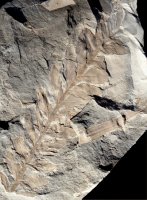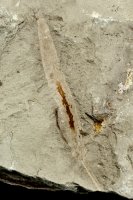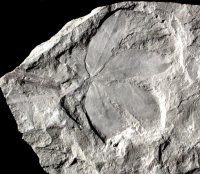| In the great extinction at the end of the Permian the seed ferns
were also hit severely, but they didn't die out. Seed ferns have been in
existence until the Jurassic, though in small numbers. They occurred also
in the Bayreuth flora. |
 Pachypteris
rhomboidalis Pachypteris
rhomboidalis was named Thinnfeldia rhomboidalis until some years ago, but the species has been transmitted to the genus Pachypteris and the genus Thinnfeldia doesn't exist anymore. In the literature the old name is still used rather often. The leaves of this plant are mostly once pinnate, but sometimes twice. The pinnules are more or less rhomboidal, but very variable. They can also be incised or lobed. The axis of the leaf is sturdy and has dots or transverse wrinkles. The midvein of a pinnule is split up at the top in a couple of equivalent veins. |
 Pachypteris
saligna Pachypteris
saligna used to belong to the genus Thinnfeldia too. This plant has undivided, slender, sometimes faintly dentate leaves. |
 Sagenopteris nilssoniana Sagenopteris nilssoniana is a striking plant with leaves like a four-leaf clover, but much larger: a stalk with four partial leaves. These show a reticulate venation in which the meshes between the veins are very long and narrow. This makes the leaves easy to identify. Mostly detached leaflets are found, but complete leaves also occur.
|
| Ctenozamites wolfiana (not pictured) is a rare seed fern of which only small fragments have been found. It has small leaves with a rounded top. |